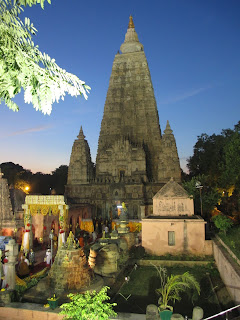One of my main goals coming to India was to cook in a Buddhist Monastery. During my first trip to India I was fortunate enough to attend 6 days of teachings lead by His Holiness the Dali Lama. During the lunch break, older chef’s and young monks would bring massive pots of rice and vegetable soup to feed the thousands of practitioners. After working at Shambhala Mountain Center and getting some first-hand experience in feeding a Buddhist community I was hopeful that my second trip to India would provide me the chance to volunteer at a Monastery. My intention was to learn from the chef’s and take a glimpse into the culture of cooking for a Monastery.
It was with this hope that I landed
on the front steps of Terger Monastery near the auspicious site of the Buddha’s
enlightenment, Bodh-Gaya. Terger Monastery
is a Tibetan Kagyu Monastery lead by His Holiness the Karmapa. The grounds where beautifully kept, which was
a rare sight considering the rest of India often lacks an uncluttered
aesthetic. Administrative buildings and
a small café bordered the large gompa (temple), which served as the centerpiece
for this bustling monastery. It was
extra bustling considering the Karmapa was in residence and preparing for a
large Monlam (religious festival/ teaching), that was scheduled to have over
ten thousand attendants.
I was slightly anxious looking at
the administrative buildings wondering which office would be my best bet for
broaching the subject of my culinary volunteering. After knocking on a few doors and being
helped by some very nice monks, I ended up at the door of the Head Lama
in charge of the Monlam. My request was
extremely low on the rung of importance considering the huge logistics that were going into the Monlam, i.e. building a gigantic permanent hanger for the
teachings, along with tents, kitchens, and toilets to handle the huge influx of
Buddhists. Fortunately the Head Lama had
been to Shambhala Mountain Center for the inauguration of the Great Stupa and
was sympathetic to my cause. Without
delay he told me he would personally bring me down to the main kitchen and see if
the cooks could use a hand in the kitchen.
After walking through the construction site we landed at a relatively small kitchen with three wood fire hearths, four gas
burners, and three Nepali head chefs.
The lama speaking in Tibetan (I think) explained why he was escorting a
foreigner into their kitchen and after some confused looks agreed to let me
volunteer in the kitchen, cutting vegetables and stuff. The kitchen was charged with the large task
of feeding over a thousand monks, almost all aged 6-17. Throughout the day one corner would pile up
with the daily order of vegetables and large groups of local Indian helpers (plus me) would chop and dice them to specification.
Every day for lunch the kitchen would produce hundreds of pounds of
rice, black lentils, and two vegetable dishes.
The food was a mix of Tibetan and Indian and had a huge helping of spicy
red chilies.

I volunteered at Terger for only
about a week but had a great time attempting to impress the other cooks with my
chopping speed. Despite the fact that
the language barrier was pretty much unsurpassable I was still able to help
out. Some of the best parts where
watching the interaction with the Chefs and the young monks. Regularly groups of monks would come to the
kitchen to do assigned chores, and it was always nice to see the Nepali cooks
rough the kids up and get into a mild food fight. I
was expecting to learn from all the differences between this kitchen and my
previous cooking jobs, but looking back I realize I learned more from the
similarities. In my head I imagined a
bunch of Zen-like cooks, all advanced practitioners who sang mantra’s while
chopping carrots with Buddha-like precision.
What I saw was a collection of poor Indians and imported Nepalese. It is the same thing that kitchens do
everywhere, cheap labor. Maybe it wasn't enlightenment with chef knives, but it was something very real and human. It was instant coffee in the morning and
drinking homemade sour coconut wine with the Indian workers. It is being reminded that cooking everywhere is long hours, hard work and if you don't love feeding people then get out of the kitchen.









Great pictures bud, those pots are massive! I hope we get to cook together in the near future. You would love the ingredients here in California.
ReplyDeleteI always getting hungry (not to mention thirsty) when I look at your facebook page. You always seem to be cooking exactly what they don't have in India. BBQ, great cheese, awesome beer. When I make back State-side we will have a culinary show-down.
Delete